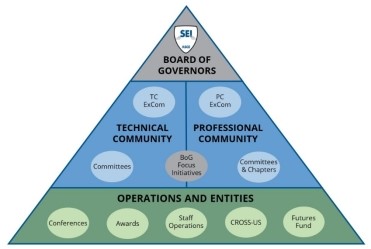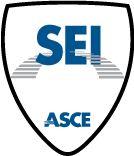This column has been describing the progress, activities, and outcomes resulting from the SEI reorganization. Recently, the SEI Board of Governors revised the graphic used to illustrate the new structure, and it has become a highly effective visual for understanding the changes.
Before explaining the graphic, let’s review the benefits gained from the SEI Reorganization:
- Increase collaboration and knowledge sharing by moving from five Divisions to two Communities: Professional and Technical.
- Become a more nimble, responsive organization to meet industry and member needs as the pace of change accelerates.
- Focus the efforts and resources of SEI to establish and meet Institute priorities for the advancement of the profession.
- Increase leadership opportunities for rising stars, so we can ensure we are building the bench for the future of institute and industry leadership.
- Streamline Institute governance for more efficient operations.
 Figure 1
Figure 1The new structure illustrated in figure 1, is easily understood and connections between the organization and the benefits of the reorganization can also be easily realized. Starting at the bottom and working our way up, each component of this graphic is key to how the new system works.
The foundation of the new SEI organizational structure is our operations. As part of the reorganization, we took a look at what activities absolutely required staff support, for example, activities requiring contracts with organizations outside of ASCE/SEI, activities requiring the distribution of funds, or activities that are impactful but out-of-sight for most of our members when done well, such as making logistical arrangements for our conferences. Operations include activities such as conferences, awards, and general staff operations.
Also included here are SEI entities that operate independently of volunteer committee work. The two entities shown – CROSS-US and the SEI Futures Fund - , are unique to SEI (compared to other structural engineering organizations), have their own boards, have unique funding mechanisms that require staff support, and each requires contracts with outside entities.
Our technical and professional communities are the next part - and intentionally the largest area - of our structure. From a streamlining perspective, we shifted from five separate divisions and five separate executive committees (ExCom) in our previous organizational structure, to two communities. Each community now has one executive committee. Examples of how this shift streamlines and reduces bureaucracy and staff load include:
- Development of ONE policy and procedures manual for both communities and operations, instead of the five separate ones we had previously, one for each division.
- Actions to sunset inactive committees and combined committees that were aligned in their activities. One example of combined committees are those related to member engagement.
At the top of the pyramid is the SEI Board of Governors, which we are in transition of reducing from 15 current Governors to 10 in the reorganization. This shift was done based on research that shows large boards struggle to make effective strategic decisions,. Large decision-making groups are also more likely to get lost in the "weeds" of day-to-day activities, instead of the strategic leadership required for a modern organization.
The Technical Community, or TC, is the home for the committees working predominately on structural engineering technical topics. This includes innovation in technical areas and the codes and standards committees for which SEI is an industry leader. The Technical Community will also include new Councils to facilitate collaboration between committees and outside research groups and representatives.
The Professional Community, noted as the PC, integrates committee efforts related to non-technical professional development. Those topics include but are not limited to leadership, business practices, digital design, licensure, diversity & inclusion, and local and global chapters. It includes member engagement initiatives at all levels, from students to young professionals to lifetime members.
Both the Technical and Professional Communities have a small Excom, which oversees activities within the community. Those Excoms plus operations are the only groups reporting directly to the Board.
The new structure also allows us to better focus SEI resources on initiatives that advance the structural engineering profession.
In the new graphic (figure 1), we have institutionalized SEI priorities by introducing FOCUSED INITIATIVES. Focused Initiatives live in the Communities, but are selected by the Board of Governors. They represent a more nimble approach to accelerated change in our world.
A focused initiative is an SEI activity identified by the SEI BOG as a priority to accelerate activities in the immediate future. Initiatives receive prioritized staff support, SEI resources, and BOG promotion. You can think of it as an accelerator – almost like a start-up business incubator - for activities the SEI Board sees as a strategic opportunity and priority for the Institute. They are re-evaluated every three years and reviewed for progress annually. The four current focused initiatives include SE2050, Young Professionals, Education and Leadership, and Performance-Based Design, as described in December last year.
This graphic illustrates how the reorganization affects each of the entities of the Institute, and also how each part of SEI and our members are supported in new ways.


